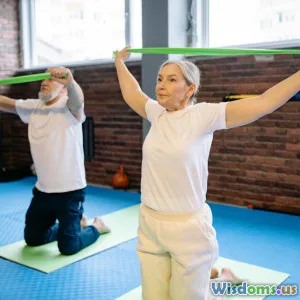
How Strength Training Reverses Muscle Loss in Seniors
9 min read Discover how strength training can halt and even reverse muscle loss in seniors, improving quality of life and independence. (0 Reviews)
How Strength Training Reverses Muscle Loss in Seniors
Introduction
Aging naturally comes with physical challenges, but among the most debilitating is the gradual loss of muscle mass and strength—a condition medically known as sarcopenia. For seniors, this muscle deterioration not only threatens mobility and independence but also increases the risk of falls, chronic diseases, and decreased quality of life. Yet, a burgeoning body of scientific research holds promising news: strength training, once thought inappropriate or too strenuous for older adults, can effectively reverse muscle loss and rejuvenate physical vitality.
In this comprehensive article, we dig deep into how strength training counters sarcopenia, the physiological mechanisms involved, and practical steps seniors can take to safely regain strength. By unraveling the powerful synergy between resistance exercise and muscle health, we aim to empower readers to embrace strength training as a transformative aging strategy.
Understanding Muscle Loss in Seniors
What Is Sarcopenia?
Sarcopenia is the progressive loss of muscle mass and strength associated with aging. Studies estimate that from age 30 onward, adults can lose 3-8% of muscle mass per decade, with the rate accelerating after age 60. By age 80, over 50% of muscle mass may be lost if no interventions occur. This decline results from a combination of decreased physical activity, hormonal changes, neurological decline, inflammation, and inadequate protein synthesis.
The consequences go beyond weakness: sarcopenia impairs balance, reduces endurance, increases insulin resistance, and contributes to osteoporosis. The National Institute on Aging highlights sarcopenia as a key factor diminishing life quality and independence among older adults.
Signs and Impact
Common signs include difficulty climbing stairs, slower walking speed, reduced grip strength, and an increased tendency to fall. According to a report in the Journal of Cachexia, Sarcopenia and Muscle, sarcopenia triples the risk of falls and fractures, costing millions in healthcare annually.
How Strength Training Counteracts Muscle Loss
The Science of Muscle Hypertrophy in Aging Adults
Muscle hypertrophy — the growth and increase of muscle cells — occurs from mechanical stress on muscle fibers, provoking a cascade of biological responses. Strength training induces micro-tears in muscle tissue, triggering satellite cells to multiply and repair fibers, leading to muscle enlargement. Crucially, contrary to myths, older adults retain the ability to increase muscle mass through resistance training.
A seminal 2019 meta-analysis in Age and Ageing reviewed dozens of studies showing seniors could gain between 5% and 15% in muscle size and strength after 12 weeks of structured training. This counters the assumption that muscle loss is unavoidable or irreversible.
Hormonal and Metabolic Benefits of Resistance Training
Strength training positively affects hormone levels including testosterone, growth hormone, and insulin-like growth factor 1 (IGF-1) which diminish with age and contribute to muscle atrophy. Moreover, it improves insulin sensitivity, helping regulate blood sugar and reducing type 2 diabetes risk prevalent among seniors.
Neuromuscular Adaptations
Beyond muscle size, strength training improves neuromuscular efficiency—the ability of muscles and nerves to communicate effectively. This leads to better coordination, reaction time, and functional mobility, which plays a crucial role in fall prevention.
Real-World Evidence and Case Studies
Landmark Studies
-
The Lifestyle Interventions and Independence for Elders (LIFE) Study: This large randomized clinical trial involving over 1,600 older adults demonstrated that a moderate physical activity program including resistance exercises reduced major mobility disability by 18%.
-
NCAA Seniors’ Strength Study: Aging elite athletes who maintained regular strength training showed negligible muscle loss after 20 years compared with sedentary peers.
Inspiring Individual Transformations
John Whitaker, 72, shares his journey of how adopting progressive strength training transformed his life: “After two months, I noticed I could lift groceries easily and climb stairs without stopping. My doctor even lowered my diabetes medication.” John’s story exemplifies strength training’s power to restore vitality.
Designing a Safe and Effective Strength Training Program for Seniors
Medical Clearance and Individual Assessment
Before starting, seniors should consult healthcare providers to tailor programs according to existing conditions. Physical therapists can assess balance, joint mobility, and cardiovascular health.
Key Components
- Frequency: 2-3 times per week allowing rest for recovery
- Exercises: Focus on major muscle groups — legs, hips, back, abdomen, chest, shoulders, and arms
- Intensity: Moderate loads (50-70% of 1-repetition maximum) progressing gradually
- Repetitions: 8-15 reps per set, 1-3 sets
Exercise Examples
- Squats or sit-to-stand
- Resistance band rows
- Dumbbell chest presses
- Leg presses
- Wall push-ups
Avoiding Injuries
- Warm-up and cool-down routines
- Start with lighter weights to master form
- Use stable equipment and avoid sudden jerks
Nutrition Support
Protein intake is vital for muscle repair. Seniors should aim for at least 1.0-1.2 grams of protein per kilogram of body weight daily, emphasizing leucine-rich sources such as lean meats, dairy, legumes, and nuts.
Overcoming Barriers and Staying Motivated
Common Barriers
- Fear of injury
- Lack of confidence
- Limited access to facilities
Solutions
- Supervised beginner classes
- Home-based programs with resistance bands
- Social support groups
Psychological Benefits
Strength training releases endorphins that reduce depression and anxiety, boosting overall well-being and adherence.
Conclusion
Muscle loss in seniors is not an inevitable prison sentence. As compelling evidence shows, strength training ignites biological pathways that rebuild muscle mass, enhance neuromuscular function, and revitalize metabolic health. The inspiring stories of seniors regaining independence and vitality are a testament to this.
By adopting structured resistance programs tailored with medical guidance, older adults can defy sarcopenia, reduce fall risks, and unlock improved quality of life. The first step might be challenging, but the transformative rewards ripple across physical health and mental resilience. In the journey of aging, strength training offers a powerful, accessible tool to reclaim strength, dignity, and joy.
The time to start is now—not just to add years to life but life to years.
References:
- Cruz-Jentoft AJ, et al. Sarcopenia: Revised European consensus on definition and diagnosis. Age Ageing. 2019;48(1):16-31.
- Liu CJ, Latham NK. Progressive resistance strength training for improving physical function in older adults. Cochrane Database Syst Rev. 2009;(3):CD002759.
- Pahor M, et al. Effect of structured physical activity on prevention of major mobility disability in older adults. JAMA. 2014;311(23):2387-2396.
- Peterson MD, et al. Resistance exercise for muscular strength in older adults: a meta-analysis. Ageing Res Rev. 2010;9(3):226-237.
- National Institute on Aging, Exercise and Physical Activity: Your Everyday Guide.
Rate the Post
User Reviews
Popular Posts



















